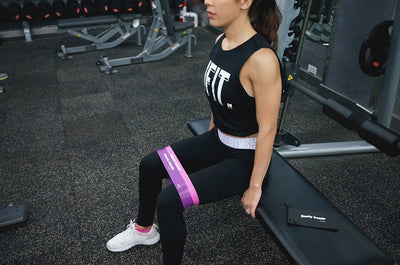Eating a healthy diet and undertaking regular exercise is fundamental to weight loss. If you want to lose body fat, then you need to expend more calories than you take in to create a calorie deficit. The most efficient way to achieve this is through using exercise to increase your daily energy consumption. (1)
Resistance training allows you to burn more calories and increase your metabolic rate, in turn burning more calories and helping you toward your goal weight. Resistance bands are an easy tool to incorporate into any full-body workout and used for both bodyweight and free-weight exercises. (2)
Here are three tips for using resistance bands for the ultimate fat loss workout.
#1 Structure
Complete a resistance band workout three to four times per week. Use both resistance and cardiovascular training to achieve your fat loss goals. The first part of your workout should focus on six to ten different bodyweight exercises that train the entire body. Perform each exercise back to back for one round, completing eight to twelve repetitions per exercise. With each consecutive round, add a resistance band to increase the intensity and difficulty of the exercise, while still maintaining correct form.(3)
#2 Exercise Synergy
Select bodyweight exercises that complement each other and work both the pulling and pushing muscles. An example of this exercise synergy would be push-ups combined with chest flyes. In this case; use the band across your back, secured under your palms, in the push-up position. For the flyes, hold the band in your hands and stretch it out. These two exercises work different areas of the back and chest and will give you optimal workout results.
#3 Intensity is Everything
Accelerate your fat loss efforts by elevating the intensity of your workout with resistance bands. Adding resistance to your bodyweight workout increases your time-under-tension, meaning that you do more work in the same amount of time. This training principle ramps up your metabolic rate and helps you burn more calories during your exercise. (4)
The Final Word
Follow each workout with some light cardio training on the treadmill or elliptical machine to cool down. When your heart rate and breathing return to normal range, your workout is finished. Never exercise less than 24 hours after completing a workout. Your recovery is as essential as your training. Training while your muscles are sore and in a depleted state can induce an injury, so make sure that your get sufficient rest and adequate nutrition. (5)
References
(1) https://www.ncbi.nlm.nih.gov/pubmed/18025815
(2) https://www.ncbi.nlm.nih.gov/pmc/articles/PMC2931407/
(3) https://www.ncbi.nlm.nih.gov/pubmed/19826285
(4) https://www.ncbi.nlm.nih.gov/pubmed/15782062
(5) https://www.ncbi.nlm.nih.gov/pubmed/21116024






